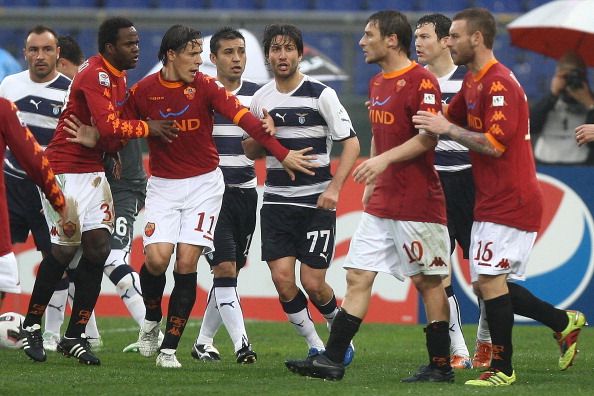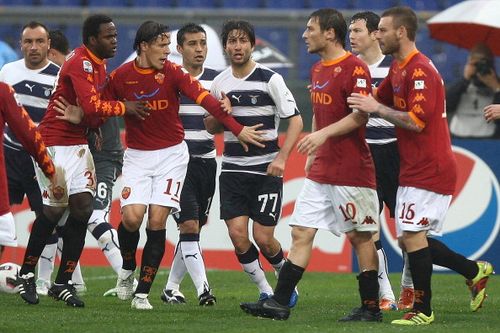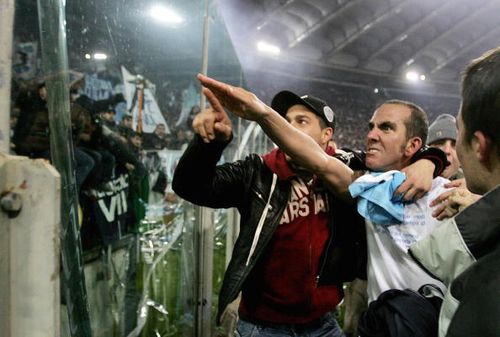
AS Roma and SS Lazio: Baying for Blood

Francesco Totti (2nd-R) and Daniele De Rossi (R) with his teammates Rodrigo Taddei #11 and Simplicio #30 of AS Roma argue with players of SS Lazio during Serie A match between AS Roma and SS Lazio at Stadio Olimpico on March 13, 2011 in Rome, Italy. (Getty Images)
The foundations of Rome are set in the bloodshed of the Trojan War, as Aeneas escaped from Troy and made his way to Italy. It’s only fitting then that the fight for domination within Rome is no less bloody than the path which Virgil’s Aeneid described.
How does one explain an event – a battle between two sets of gladiators really – where the member of one group asks the audience to “leave their weapons and knives at home” before taking their seats at the present-day Colosseum that is the Stadio Olimpico? And we are talking of the same person who, in the previous meeting between the two, punched an opponent in the face.
Never has Bill Shankly’s legendary quote about football being more important than life and death ever been more true than it is for the Rome derby. Fans have died – and rumoured to have been killed – in and around the stadium, matches have been suspended by “Ultras” walking onto the pitch and riots have broken out in the stands. The derby in early 2004 saw most of it occur, with multiple arrests and more than 150 policemen alone injured. A Lazio-Roma match-up without the routine tear gas shells from the police and the associated violence is quite simply, boring.
But then, Rome isn’t any other city. Housing the Vatican within its walls, the passion and fanaticism of the supporters for their clubs rivals the faith in Christianity itself. Like most cities with multiple clubs, the footballing rivalry becomes the physical manifestation of deep-lying territorial issues. However, with Rome being Italy’s capital and the centre of political battles of yore, it’s not surprising that Italy’s fascist past has influenced the city’s football since the inter-war years.

Referee Paparesta (R) gives the yellow card to Lazio’s Paolo Di Canio, flanked by AS Roma’s Francesco Totti during an Italian Serie A match AS Roma-Lazio in Rome 23 October 2005. (Getty Images)
Given the fact that SS Lazio was founded in 1900 – 27 years prior to the formation of AS Roma – it’s interesting that the Roma supporters proclaim Roma as the true club of the capital. Created by the consolidation of three Rome-based clubs (Fortitudo-Proroma, Roma Football Club and Alba-Audace) in 1927 on the instructions of Benito Mussolini to counter the strength of the giants from Milan and Turin, the rivalry was created due to the resistance put up by Lazio against the merger of the Rome clubs, helped by the influence of the Fascist general Giorgio Vaccaro. Thus, the creation of a single identity was denied.
What made matters worse was that Lazio fans were up against multiple sets of supporters brought under the umbrella of AS Roma, and this strengthened their resolve to support the only club they knew. Additionally, the adoption of the colours yellow and red as the new club’s colours further infuriated Lazio. The differences continue till today, with Roma’s supporters considering themselves as urban, middle class and the left-wing, while Lazio supporters are viewed as the right-wing, urban upper class and those from the surrounding suburbs and rural areas – resulting in Lazio fans being labelled as “peasants.”
But if anything contributes and adds to the roaring inferno that is the Derby della Capitale, it’s the lack of success for the two clubs nationally. In their eighty-six years of co-existence, Lazio and Roma have won the Scudetto a measly five times between them, while their Northern rivals – Juventus, Torino, Inter and Milan – have won sixty-five in the same time interval. This lack of success in the league led to the derby acquiring an importance barely seen anywhere else in Europe. When title expectations are low – as they have been – the focus and passion turns to the local derby, with stakes rising beyond the proverbial bragging rights.
The turn of the millennium saw the rivalry take an incredible turn, when Lazio won the Scudetto in 1999-00, after a gap of 26 years. The triumph was fuelled by the arrival of Sergio Cragnotti, a wealthy businessman who oversaw the purchase of numerous big-money signings like Juan Sebastian Veron, Christian Vieri and Hernan Crespo. The lavish spending culminated in the domestic double in 1999-00 under Sven-Göran Eriksson. However, Roma were not to be outdone, and they responded in turn by winning the league the following year under Fabio Capello, who had been appointed manager the previous year. The Roma team of the early 2000s contained the likes of Cafu, Gabriel Batistuta, Vincenzo Montella, Walter Samuel, Emerson and a certain Francesco Totti – a local boy who has grown to live the supporter’s dream.

Pictured in 2005, Lazio’s Paolo Di Canio gestures towards Lazio fans at the end of Lazio vs AS Roma Serie A football at Rome’s Olympic stadium. (Getty Images)
A veteran of more than 650 games for the club, Totti continues to be worshiped by the Romanista twenty years after he made his debut. Lazio fans, meanwhile, have had a unique representative in the team in the past: Paolo Di Canio. A one-time Lazio ultra, Di Canio played for the club twice in a career spanning more than twenty years. Even though his appearances for Lazio totalled just over a hundred over seven seasons, there is no doubting his legendary status among the supporters, with his explosive nature and hate for Roma exemplified by his fascist salute to the Lazio end after winning the derby 3-1 in January 2005. With one gesture, Di Canio had aligned himself with the right-wing sections of Lazio’s supporters and confirmed his place in SS Lazio’s annals.
While violence in football stadiums has reduced considerably since the hooliganism of the 1970s and 1980s, Rome seems to be immune to such changes. Come Sunday, 2000 policemen will line up in and around Stadio Olimpico, with bragging rights, the Coppa Italia and the chance to compete in the Europa League waiting for the victors. Come Sunday, football will become more important than life and death again.